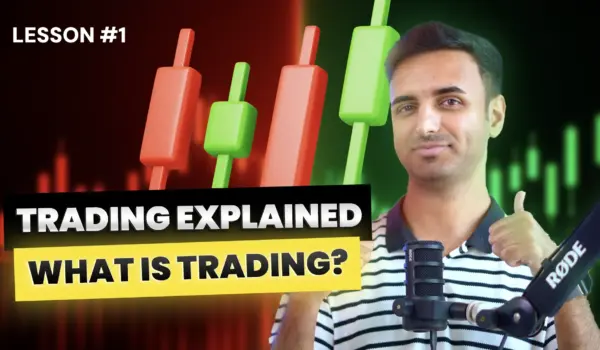What Is Trading? Ultimate Guide for Beginners

What is Trading?
Trading is the practice of buying and selling financial instruments like stocks, cryptocurrencies, foreign currencies (forex), commodities, and derivatives, with the goal of making a profit from fluctuations in their prices. Traders leverage market volatility by strategically entering and exiting trades based on comprehensive analysis, strategic insights, and established methodologies.
Understanding Financial Markets
Financial markets serve as platforms where assets are traded. Each market functions uniquely, providing distinct trading opportunities:

1. Stock Market
The stock market allows traders to buy and sell shares of publicly listed companies. Traders conduct thorough analyses of company performance, market trends, economic indicators, and geopolitical influences to forecast stock price movements.
2. Forex Market
The forex market is the largest and most liquid global market, where traders exchange currencies. Factors influencing currency values include interest rates, economic growth, geopolitical stability, inflation rates, and government policies.
3. Cryptocurrency Market
Cryptocurrencies such as Bitcoin, Ethereum, and altcoins offer traders opportunities characterized by extreme volatility. Price movements in crypto markets are driven by technological advancements, adoption rates, regulatory updates, speculative interest, and general market sentiment.
4. Commodity Market
Commodities, including precious metals (gold and silver), energy (oil and gas), and agriculture (grains, livestock), are influenced by supply-demand dynamics, weather conditions, economic cycles, geopolitical events, and government policies.
5. Derivatives Market
Derivatives include financial instruments like futures, options, and contracts for difference (CFDs), whose value is derived from underlying assets. Traders use derivatives for speculation, hedging, and managing exposure to risks in volatile markets.
Reasons People Trade
Individuals participate in trading for multiple reasons:
- Financial Gain: To achieve significant profits and financial growth.
- Financial Freedom: To attain independence from conventional employment structures.
- Portfolio Diversification: To spread risk across various investment types.
- Risk Management (Hedging): To protect existing investments from adverse price movements.
- Intellectual Challenge: Trading provides continuous opportunities for strategic thinking, analysis, and personal growth.
How Trading Works
Effective trading requires an understanding of critical market mechanisms:
Buyers and Sellers
Markets consist of buyers willing to purchase at bid prices and sellers willing to sell at ask prices. The difference between these prices, known as the spread, represents a key transactional cost in trading.
Trading Platforms
Brokers and exchanges offer platforms enabling traders to execute trades. These platforms provide essential analytical tools, real-time data, charting software, market news, and trading alerts.
Orders
Different types of orders facilitate effective trading:
- Market Order: Executes immediately at prevailing market prices.
- Limit Order: Executes at a specified price or better.
- Stop Order: Triggers a market or limit order when a defined price point is reached.
Common Trading Styles
Traders adopt various approaches to market participation:
1. Scalping
Short-term, rapid trades that capture small price movements to accumulate consistent profits throughout the trading session.
2. Day Trading
Positions opened and closed within a single trading day to capitalize on intraday volatility and avoid overnight risk exposure.
3. Swing Trading
Positions held over multiple days or weeks to capture larger price movements resulting from sustained market trends.
4. Position Trading
Long-term trades based on fundamental and macroeconomic analysis, aiming to benefit from significant market trends over months or years.
5. Algorithmic Trading
Automated trading systems utilizing mathematical models, historical data, and predefined strategies to execute trades systematically, removing emotional decision-making from the process.
Essential Trading Tools
Successful traders utilize an array of analytical and strategic tools:
Technical Analysis Tools
- Indicators (RSI, MACD, Bollinger Bands)
- Chart patterns (head-and-shoulders, triangles, wedges)
- Support and resistance levels
Fundamental Analysis Tools
- Economic calendars
- Financial reports and corporate earnings
- Macroeconomic indicators (GDP, unemployment rates, inflation)
Risk Management Tools
- Stop-loss orders
- Take-profit orders
- Risk-reward ratios
- Position sizing calculators
Risks and Challenges in Trading
Trading involves inherent risks:
- Market Risk: Volatility and unexpected price movements can cause substantial financial losses.
- Leverage Risk: Borrowed funds can amplify both profits and losses, requiring careful risk management.
- Psychological Risks: Emotional trading decisions driven by fear, greed, or impulsivity.
- Liquidity Risk: Challenges in executing trades quickly at desired prices in less active markets.
Steps to Start Trading
Step 1: Choose Your Market
Identify markets aligning with your financial goals, interest, and risk tolerance.
Step 2: Select a Reliable Broker
Evaluate brokers based on reputation, regulatory compliance, trading costs, available instruments, and technological infrastructure.
Step 3: Use a Demo Account
Demo accounts provide practice opportunities with virtual money, allowing traders to develop skills and test strategies without financial risk.
Step 4: Learn Trading Strategies
Explore diverse trading methodologies, technical and fundamental analysis techniques, and identify strategies matching your personal trading style.
Step 5: Start Trading Small
Begin with modest capital allocations to manage risk effectively and build experience through incremental progression.
Advanced Tips for Traders
- Clearly define trading objectives and realistic expectations.
- Maintain a detailed trading journal to track performance, refine strategies, and improve decision-making processes.
- Continuously invest in education and skill enhancement through courses, webinars, books, and mentorship programs.
- Apply disciplined risk management practices consistently to protect trading capital.
- Regularly review and adapt trading strategies based on performance data and evolving market conditions.
Conclusion
Trading provides significant potential for financial prosperity and personal fulfillment but demands commitment, consistent education, and disciplined execution. By thoroughly understanding market dynamics, employing effective strategies, and responsibly managing risks, traders can steadily build expertise and achieve sustained success in financial markets.

